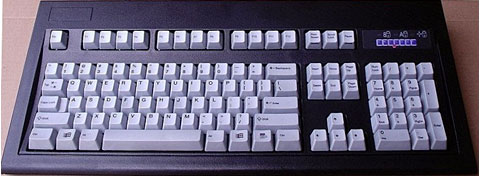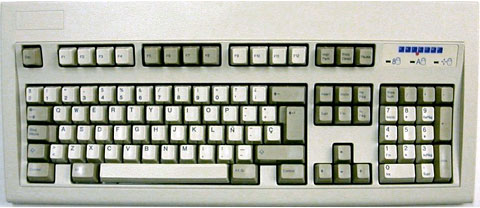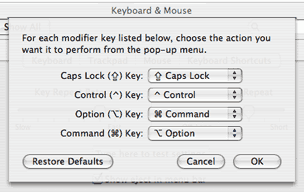Keyboard preferences are nothing if not idiosyncratic, so
designating a "best keyboard ever" is a subjective judgment.
Personally, I'm very partial to the keyboards in my WallStreet and Pismo PowerBooks, and I also
like the action and feel of the Kensington SlimType external keyboard.
However, for many veteran Mac users, the old ADB Apple Extended Keyboard II of the early 90s
with its ALPS mechanical keyswitches, represents the ultimate computer
keyboard ever.
Other keyboard aficionados beg to differ, contending that the ne
plus ultra of computer keyboards was IBM's Model M, whose mechanical keyswitches
operated on the patented "buckling spring" principle in which a coil
spring supporting the keycap runs vertically down to a knob sticking up
from the pivot point of a rocking actuator switch, but slightly angled
off vertical so that as the spring is depressed it bows outward a
little to a point where it rocks the key actuator switch "over-center"
with an audible click - which accounts for the clickety-clacking sound
these keyboards are famous for.
Personally, I've never been that taken with the Apple Extended
Keyboard II (I've had one for years), but I do rather like the action
of the IBM buckling spring type keys.
While the now-ubiquitous, cheaper, and much quieter rubber dome type
and variant scissors-action type keyswitches have all but displaced
mechanical keyswitches from the computer keyboard market, there are a
few holdouts, such as the Matias Tactile
Pro keyboard, which uses ALPS-type keyswitches, and fans of the old
and arguably superior IBM buckling spring switches will be happy to
learn that manufacture of the Model M keyboard, which passed from IBM
to Lexmark International, since 1996 has been licensed to a Lexington,
Kentucky firm called Unicomp, a
company founded by former IBM keyboard specialist Neil Muyskens.
Unicomp not only uses the original IBM buckling spring technology,
but even the original molds for the plastic enclosures, and while the
Unicomp keyboards sell for somewhat more than run-of-the-mill rubber
dome keyswitch type 'boards, at about $70 they're far from the most
expensive keyboards on the market, and when you consider that they are
partly hand-made, that sounds like a bargain.
Unicomp offers several keyboard models, along with a variety of
other input devices and peripherals, but of particular interest in the
context of this article are four buckling spring action keyboards.
Customizer 101

The Unicomp Customizer 101 keyboard
Unicomp's newest 'board model, the Customizer 101, is available in
either PS/2 or USB versions with your choice of buckling spring
technology, for that classic IBM "click" feel, or quiet rubber dome
keyswitches.
The Customizer
101 sells for $69.
Customizer 104/105

The Unicomp Customizer 104/105 keyboard
Customizer is the marketing name Unicomp has given to its classic
IBM-style keyboards, also available in either USB or PS/2 versions, as
well as a variety of languages. The Customizer 104/105 comes in black
with metallic gray buttons.
The Customizer
104/105 also sells for $69.
Customizer 102/103 Pearl White

The Unicomp Customizer 102/103 Pearl White keyboard
If you prefer a white keyboard (as I do) the Customizer is also
available in the 102/103 Pearl
White model, which can be had with either buckling spring or rubber
dome keyswitches in USB and PS/2 versions, and likewise sells for
$69.
Endurapro 104

The Unicomp Endurapro 104 keyboard
The Endurapro 104
features buckling spring technology plus an integrated mouse
substitute, as well as a footprint 20% smaller than Unicomp's
conventional keyboards. It sells for $99.
 For Mac-users, although the
USB versions of these keyboards will work fine with Macs, the downside
is that there are no Apple-labeled versions available, so one has to
put up with a Windows Key logo where the Option key should be, and a
key labeled Alt where the Command key would be on a Mac
keyboard. I've never found having to use Windows labeled keys a
deal-breaker, but some folks might, so caveat emptor.
For Mac-users, although the
USB versions of these keyboards will work fine with Macs, the downside
is that there are no Apple-labeled versions available, so one has to
put up with a Windows Key logo where the Option key should be, and a
key labeled Alt where the Command key would be on a Mac
keyboard. I've never found having to use Windows labeled keys a
deal-breaker, but some folks might, so caveat emptor.
It will also be preferable to reverse the programming of the Option
(Windows) and Command (Alt) keys, which can be done in the OS X
Keyboard & Mouse system preferences.





 For Mac-users, although the
USB versions of these keyboards will work fine with Macs, the downside
is that there are no Apple-labeled versions available, so one has to
put up with a Windows Key logo where the Option key should be, and a
key labeled Alt where the Command key would be on a Mac
keyboard. I've never found having to use Windows labeled keys a
deal-breaker, but some folks might, so caveat emptor.
For Mac-users, although the
USB versions of these keyboards will work fine with Macs, the downside
is that there are no Apple-labeled versions available, so one has to
put up with a Windows Key logo where the Option key should be, and a
key labeled Alt where the Command key would be on a Mac
keyboard. I've never found having to use Windows labeled keys a
deal-breaker, but some folks might, so caveat emptor.
